4. Biochromes¶
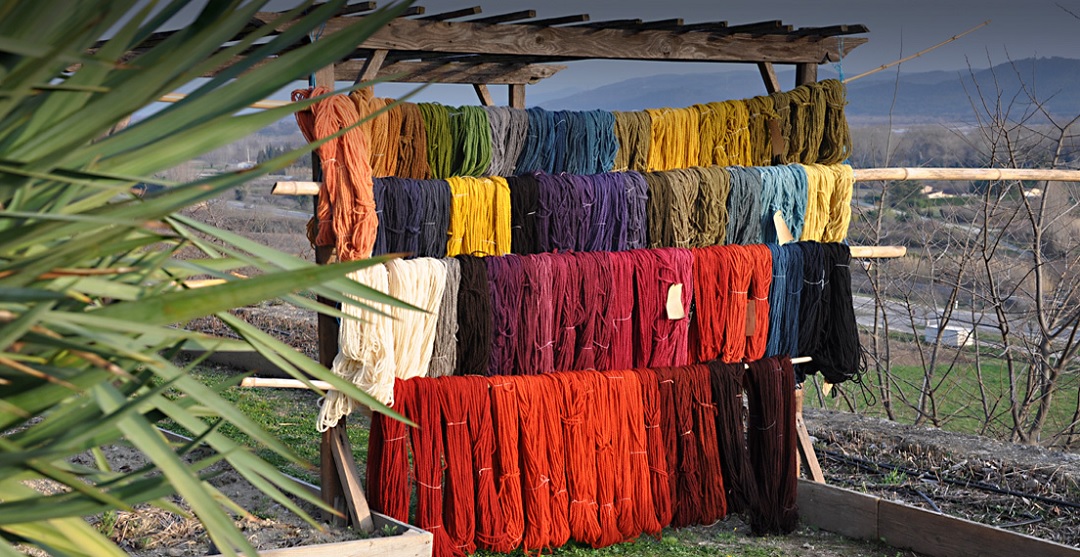
This week we explore Natural Dyes,Inks and even Colors made by Bacteria
Program¶
As I don't have lots of opportunity to be at Onl'Fait FabLab we will try to discover the 3 subjects in the same afternoon.
So we will start with the bacteria colors, then trying one or two dyes and finally one ink color.
After that the idea for me is to choose one of the natural dies and use it to colored all the patterns cut on week03
Pigments produced by Bateria¶
Nomenclature of Bacteria¶
Nomenclature of bacteria refers to naming and bacteria and other organisms are named according to the binomial system, which was introduced by Carl Linnaeus (1674-1748). This means that a bacterium has a species name, which is composed of a genus name that tells you to which genus it belongs and a species epithet which, together with the genus name, is unique to the bacterium. An example of this is Moraxella bovis, where the genus name indicates that the bacterium belongs to the genus Moraxella and the species name indicates that the bacterium has been isolated from cattle. The genus name and the species epithet form together the scientific name of the species, which is always written in italics. Bacterial names are international and Latin or latinized Greek are used to form the name. If misunderstandings cannot occur, you can abbreviate the genus name after it has been written for the first time in a text, e.g. M. bovis. However, note that there are also bacteria called Mycoplasma bovis and Mycobacterium bovis.
There are strict international rules for how bacteria should be named and these rules are published in a book named: "International Code of Nomemclature of Bacteria". In order to get a proposed name accepted, a scientific paper on the proposed species must be published and approved by an international taxonomy committee. Trivial name
Trivial names are often used as a simplified way of naming a bacterial genus. A trivial name should neiter be written with capital first letter nor in italic. Examples of trivial names are: lactobacilli, mycobacteria, salmonella, staphylococci and streptococci. The scientific names for these groups are: genus Lactobacillus (or Lactobacillus spp.), genus Mycobacterium (or Mycobacterium spp.), genus Salmonella (or Salmonella spp.), genus Staphylococcus (or Staphylococcus spp.), genus Streptococcus (or Streptococcus spp.), respectively.
If you refer to a specific bacterial species, a trivial name refering to a complete genus should never be used. Subspecies, biovars and serovars
Sometimes there is a need to divide bacterial species into subspecies, because they are too closely related to be regarded as different species, but too distantly related to be regarded as the same species. In this case a subspecies is introduced by adding a subspecies epithet and write subspecies (subsp. or ssp.) in front of it. An example of this is Streptococcus equi subsp. equi. When you divide a species into several subspecies, the original species always gets the same subspecies epithet as the species epithet.
There is often a need to divide species and subspecies in different biovars (biological variants) or different strains, but this is not strictly regulated, which means that researchers themselves can name their strains or biovars. One type of biovar is serovar (serological variant), by which various surface antigens can be identified with specific antibodies. Contact tracing and epidemiology is based on identification of different variants of the same bacterial species.
Our Bacterias¶
Janthinobacterium lividum
Micrococcus luteus
Preparation¶
We have 20 Petri Dishes in a sealed bag, Let's prepare 20 piece of material (coton & wool) and the nutriment for the bacterias then put them in the "autoclave"
LB (Luria-Bertani) agar, 25g/L So we 2 bottles of 200ml with 5g in each.
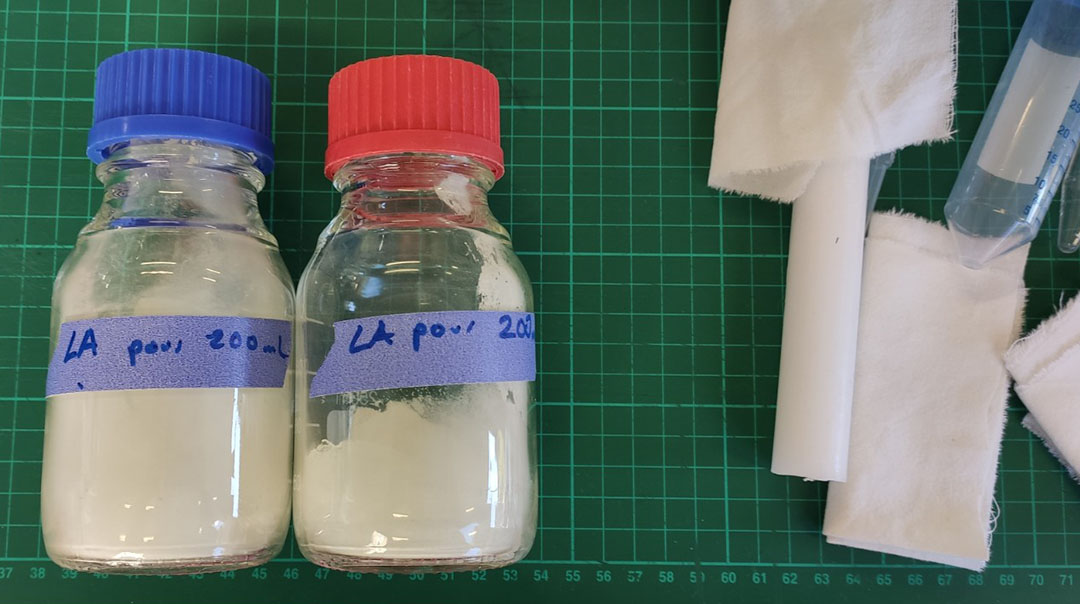
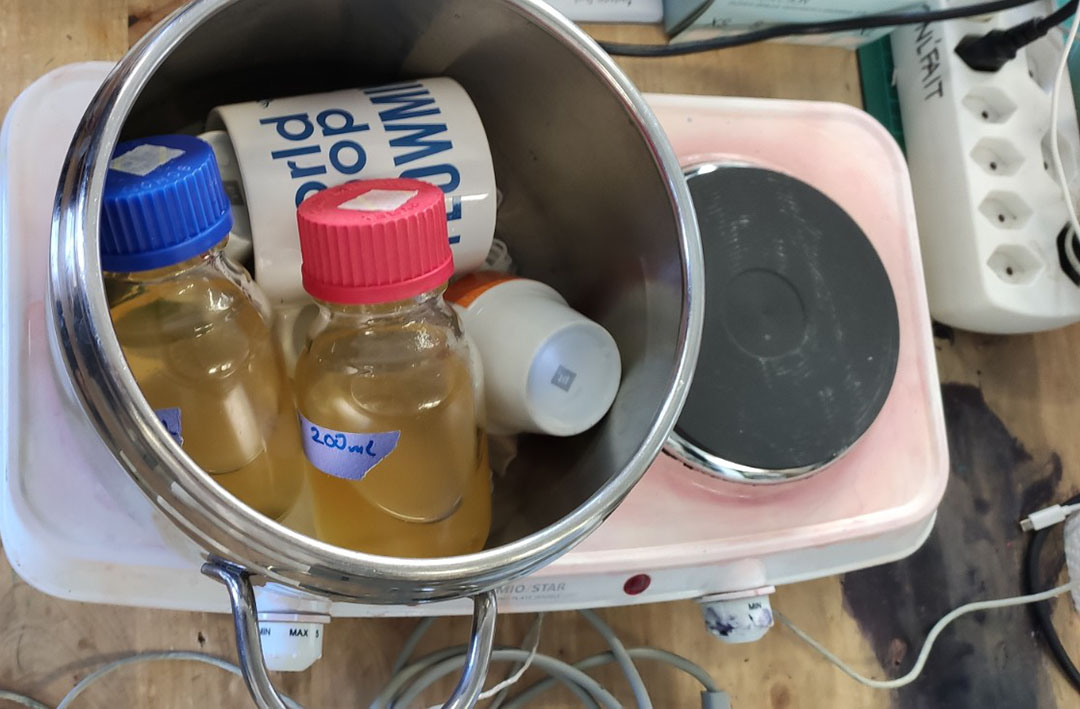
Then we count 15min when the "cocotte" is under pressure. (in a normal autoclave it should be 15 Min à 121°C)
Then we let it cooldown and prepare the Petri Dishes on the table because we will need to act quickly.
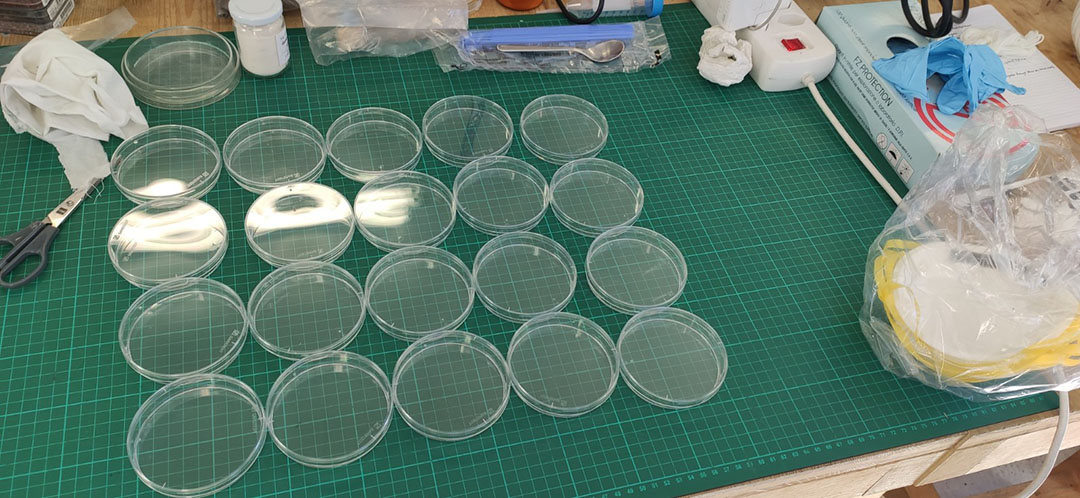
In the first cycle after the opening of the "cocotte" we will put Coton or Wool under each dish.
then in each dishes over the material we have to put the nutriment (20 Dishes, 400Ml --> 20Ml by dishes.)
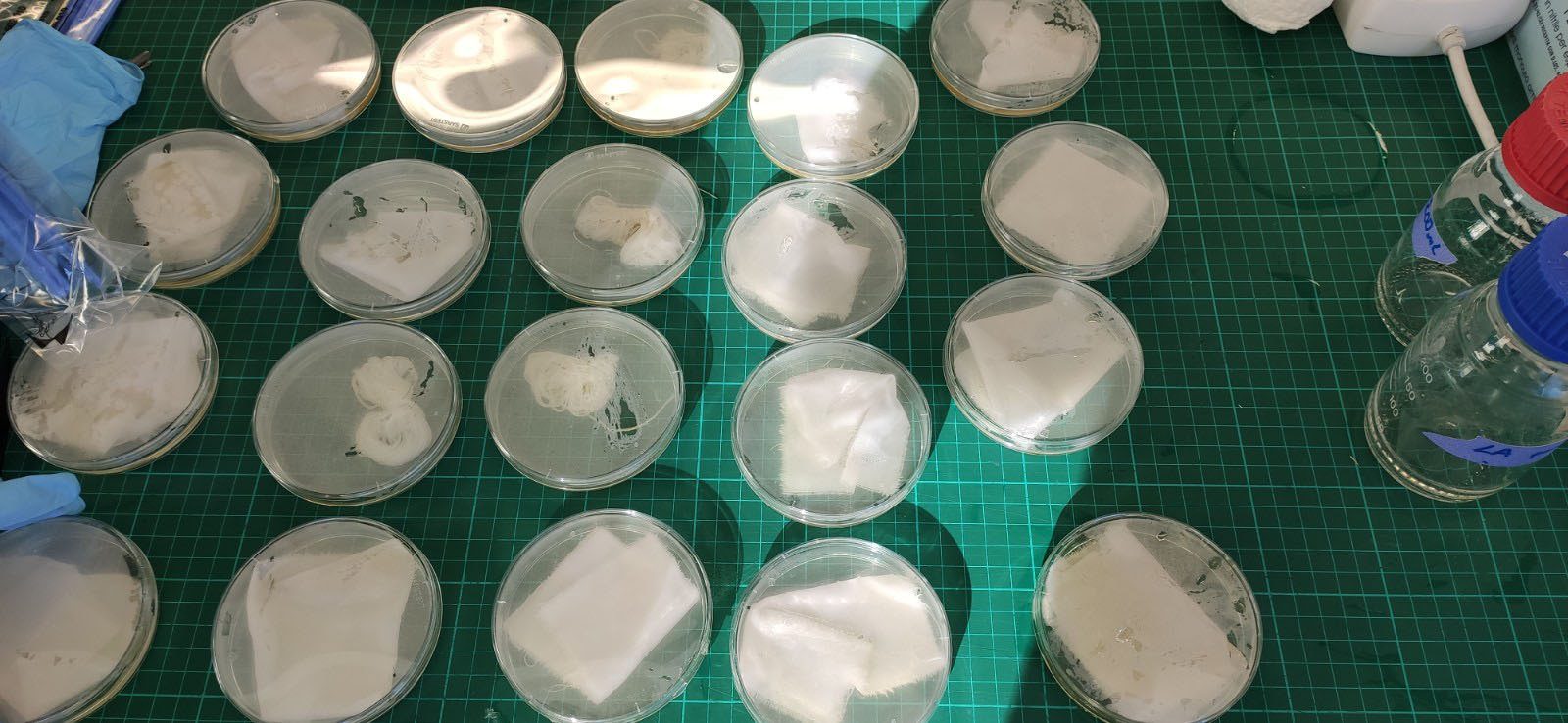
We wait until the nutriment cooldown and stop to be liquid, finally in each dish we have to transfert bacteria fron the Culture
When it's done we can regroup the petri Dishes in a bag and put it in a dark space
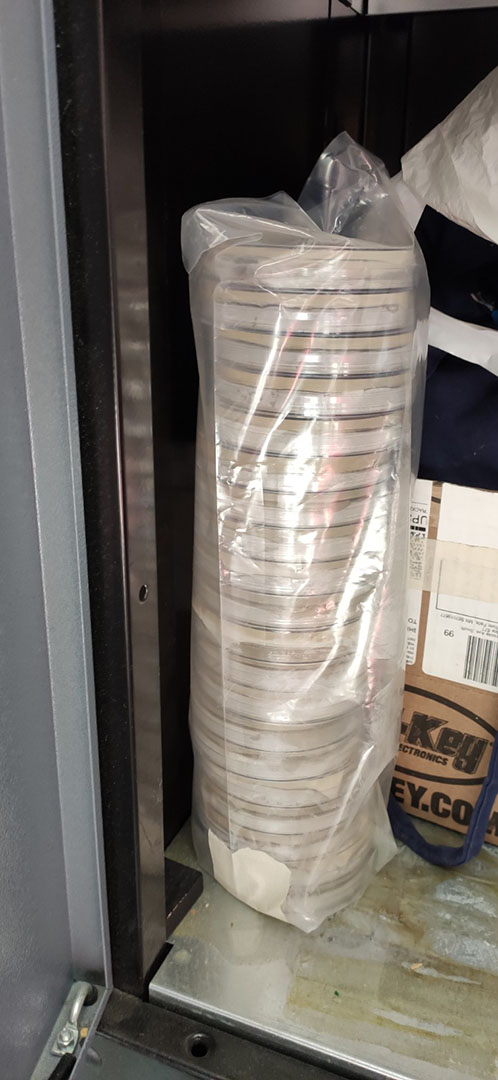
The result after one week:¶

After the clean up of the coton pieces, we can say that the Micrococcus luteus (yellow) was not working so much: the color was not intense and was not really fixed on the support. On the other hand Janthinobacterium lividum (purple) was working well and I like the marble effect.

I would say that using bacteria for dyeing is a complicated process, and if you want to use it over a large area, you need to have proper equipment and space in your laboratory. Moreover it smells so bad and asks to respect the bioHazard procedure.
CleanUp¶
At the end, you need to take a few precautions to clean up any single-use equipment like petri dishes that need to be placed in a special bag and given to someone who works in a laboratory in order to receive proper treatment.
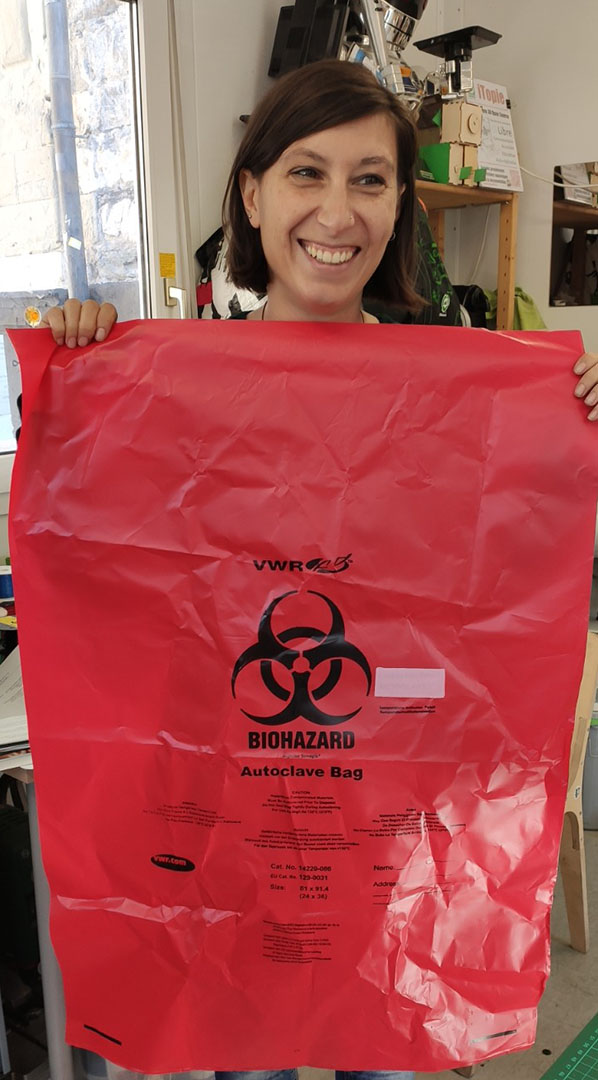 Cristina Olivotto: one of the key person from fablab "On l'fait"
Cristina Olivotto: one of the key person from fablab "On l'fait"
Natural Dyes¶
preparation of the fiber¶
Amimal fibers(Wool): wash the fiber with little bit of soap with luke warm water 20°C, be gentle and rinse at same temperature.
Vegetal Fiber(Cotton): Boil the fibers for an hour in water and sodium carbonate (soda ash) ±2 spoons for 4 liter water. This process will remove the oil and waxes that are naturally presentin the fibers. It’s good to repeat this process twice or to start by washing the fibers at a high temperature in the washing machine.
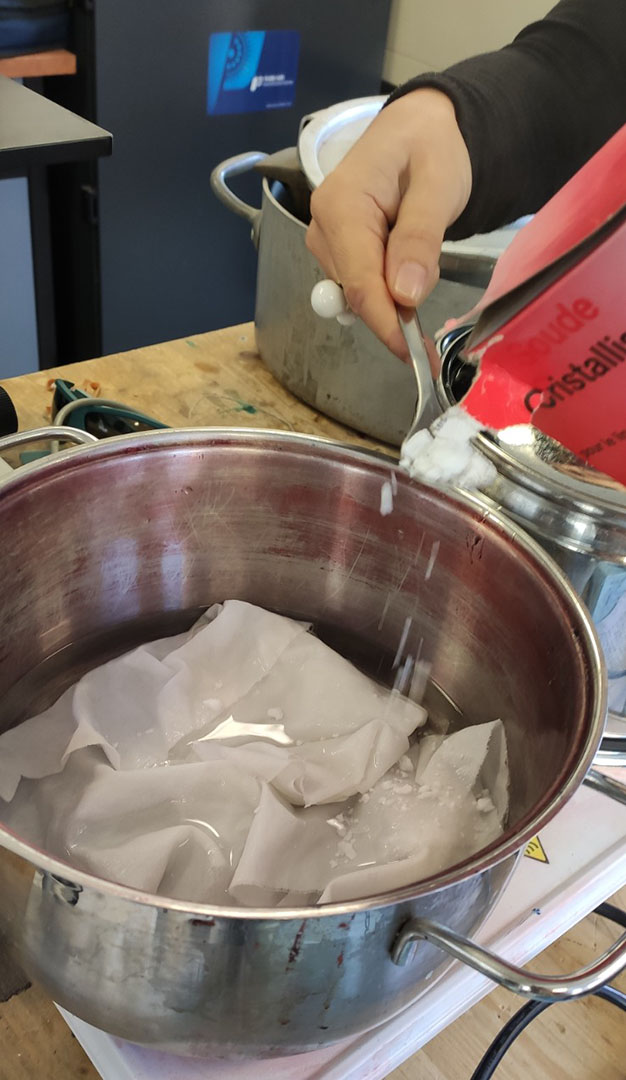
Then we need to treat the fabrics with Mordant. Mordant or Dye fixative is a substance used to set dye on fabrics by forming a coordination complex with the dye,which then attach to the fabric. it exists plenty of mordants including tannic acid, alum, chrome alum, sodium chloride, and certain salts of aluminium, chromium, copper, iron, iodine, potassium, sodium, tungsten, and tin.
here with Hibicus and Garance we will use ALUN mordant, the idea is to put enough warm water (about 25 degrees) to cover completely the textiles. Add 15% of weight of fabric of alum and let the textiles in the dye bath for 15 minutes

Then I will use half of the fabric for HIBICUS and the rest for GARANCE
Hibicus¶
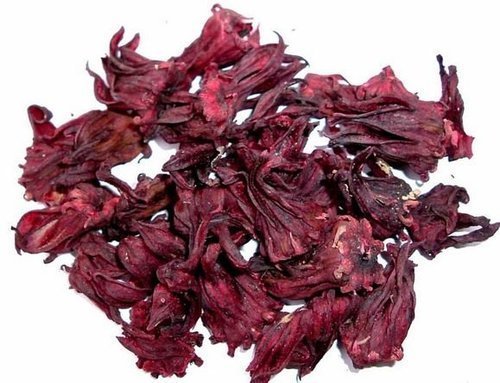
To extract the dye color: pour boiling water over the flowers, then simmer them for half an hour. a. How much dried flowers? 1/4 Weight of fabric for bright fuchsias 1/8 Weight of fabric Hibiscus for pinks and lilacs
Leave the flowers in the dye bath.
Normally you have to Simmer the fibers in the dye liquid for about 45 minutes, basically Leave them to as long as you wish (the longer, the more intense the color will be)
For the experimente I will use 8 pieces of coton, and after 5 min and every 5 min I will extract one sample.
then I will rinse the fabrics and let them dry.
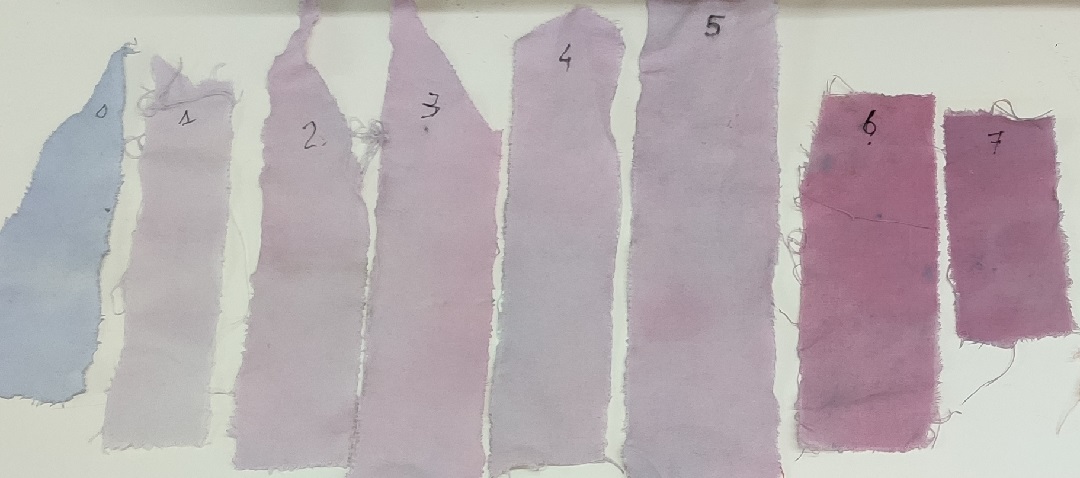
Garance¶

The pigment is extracted from the roots of the plant, here we have it in powder.
Pour the powder into a large saucepan hot water (about 45 degrees)
Immerse a piece of coton in this bath: the color will appear very slowly, first orange then more and more red.
A slow rise in temperature and a extended duration guarantees good success. Born not boil (about 80 degrees) Rinse the piece of cloth with lukewarm water until get clear water and dry.
As for the Hibicus I have 15 pieces and the idea is to put them one by one in the saucepan. so I bring the temperature up to 50~60 and every 5 min I will add one piece then I will extract them all at the same time.
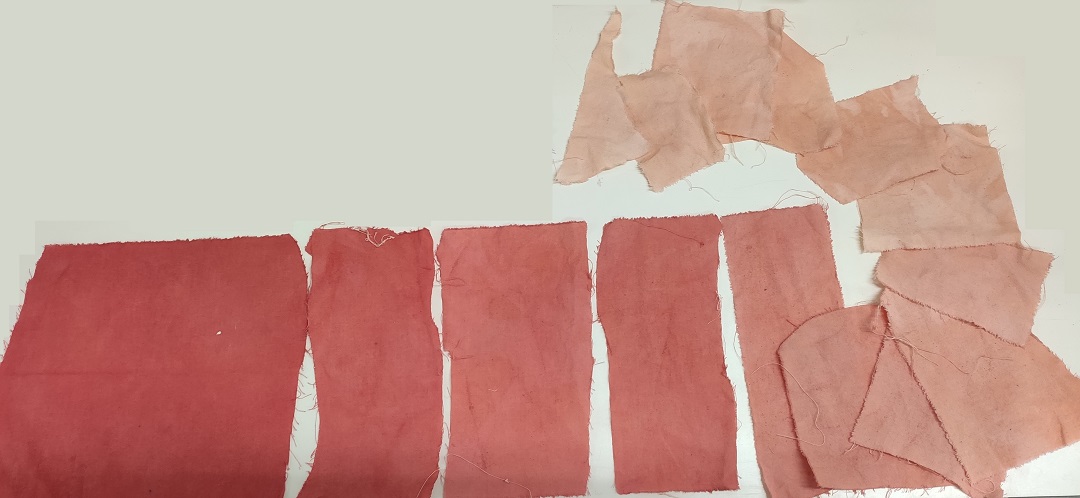
We can see that nuances appear really after 30~40 min. I really like the gradient of color and I will use it with the cut pattern of the week02.
So I redo the whole process with pattern pieces :here the thickness of the coton is big so I will clean them up with hot water and soap , then with soda , then applied the mordant
 I also used some rubberband on a largepiece of coton to avoid uniformity and create shapes
I also used some rubberband on a largepiece of coton to avoid uniformity and create shapes
At this time my phone run out of battery so there is no pictures of the process, but you can see the result after drying:


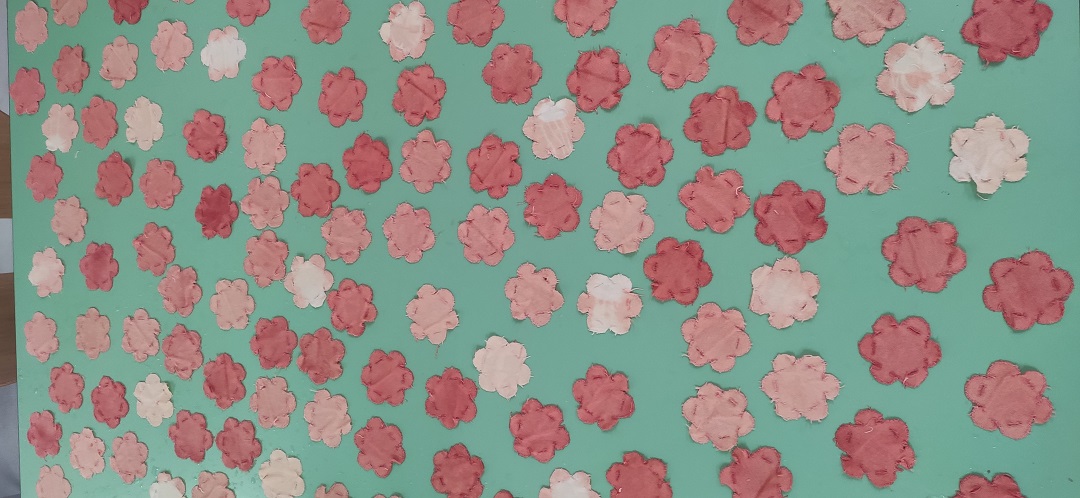
Then After 2 episodes of my TVserie of the moment:
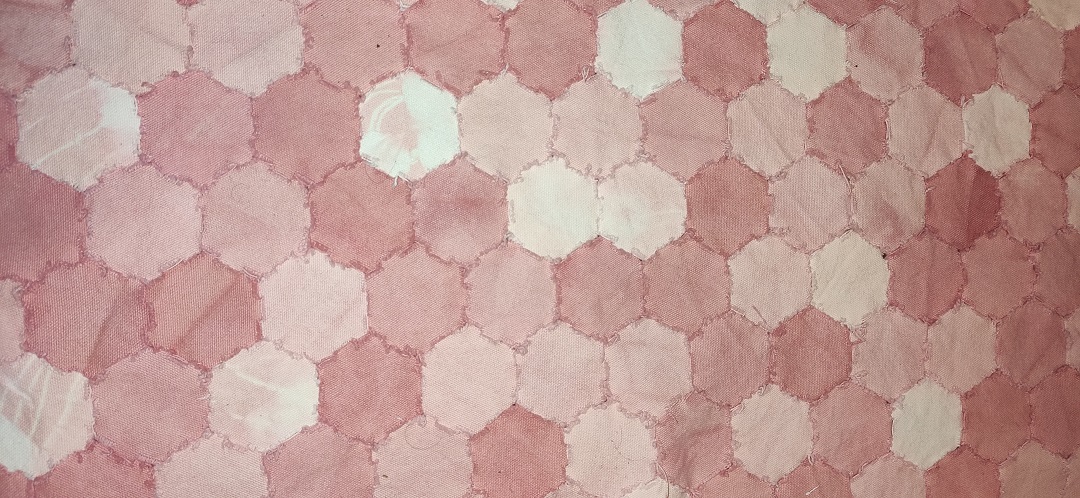
To Be Continued...
Inks¶
There is 3 categories of componants : - the vehicle, the liquid in which the pigment is suspended, it could be water,ethanol,oil or gel - the binder, the substance that acts like a glue between the dye stuff and the vehicle, usually arabic gum - the additive, the substance that helps stabilising, intensifying,modifying, preserving or thickening the ink. could salt, vinegar,metals.
In my case I will mainly use Water as vehicle and Arabic Gum as Binder then I will with and without salt.
I Will try 4 plant sources and one animal, but the process is the same each one of them:
- put the dye powder inthe water
- boil down the dry die stuff into a thick liquid
- add arabic gum to thicken the ink
- add salt to stabilise it.
indigo¶
 Nice blue with a little bit of gray
Nice blue with a little bit of gray
Garance¶
 Still my favorite
Still my favorite
Nussshale¶
 A little bit light brown
A little bit light brown
Anottosamen¶
 The color was really pale, seeds were too dry, maybe needs to be under water a long time before boiling
The color was really pale, seeds were too dry, maybe needs to be under water a long time before boiling
Cochenille¶
 Really strong color with really small quantity of cochenille
Really strong color with really small quantity of cochenille